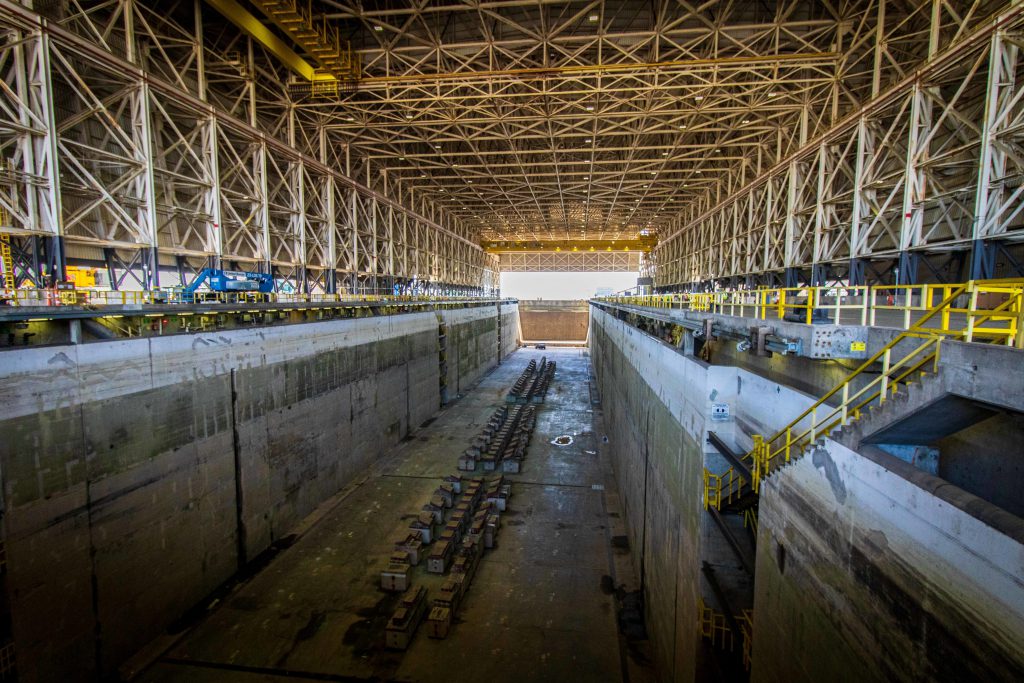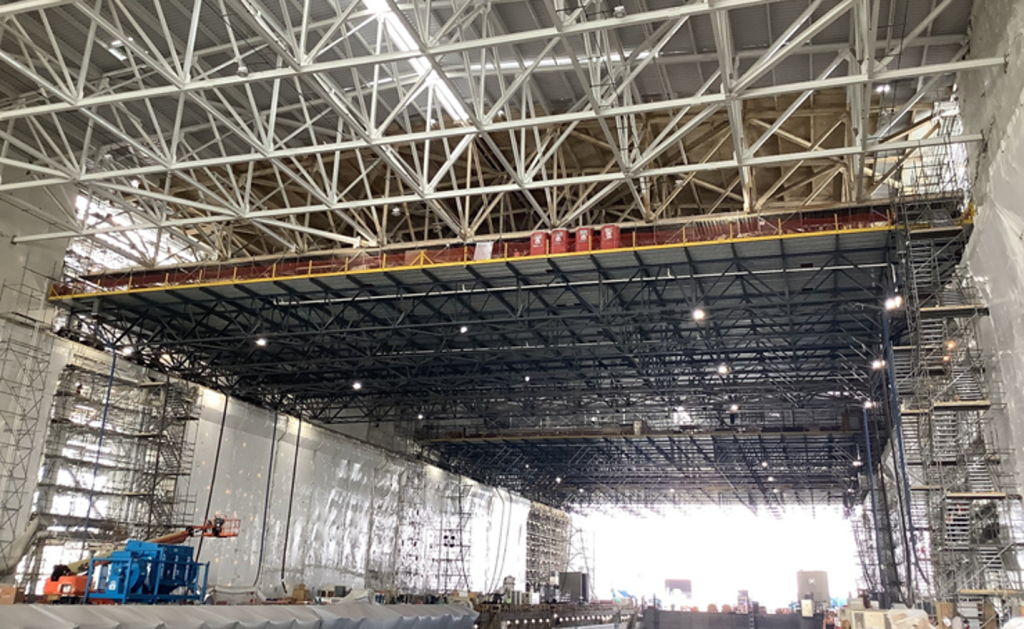By Lt. Cdr. John Orr, P.E., PMP, CEC, USN
Standing more than 130-ft tall and extending more than 1,100-ft in length, the dry dock of Naval Submarine Base Kings Bay, Ga., is the largest covered dry dock on the East Coast. The dock is equipped with a 700-ft long by 100-ft wide by 67-ft deep basin, capable of housing an Ohio-class ballistic missile submarine—among the most critical assets in the U.S. Navy’s strategic deterrence mission set. This massive facility has conducted over 150 submarine dockings since 2016 and boasts a utilization rate of more than 85 percent.
In July 2021, for the first time in the past decade, the Navy shut the dry dock down and handed it over for a much-needed overhaul to Naval Facilities Engineering Systems Command (NAVFAC).
NAVFAC, led by the newly stood up Resident Officer in Charge of Construction (ROICC) Trident, was given a 15-month window to complete more than $340 million in repairs. The expansive scope included a full electrical overhaul, complete systematic mechanical replacements, significant concrete repair within the basin, structural enhancements across the facility, and the overhaul of the dry dock’s two 85-T bridge cranes.
The greatest challenge to the project team, however, was not within any single scope area, but rather the simultaneous execution of all the scopes within a constrained timeline.

PARTNERING MINDSET
In October 2022, the new dry dock at Kings Bay was officially reopened, ready to serve as a cornerstone in the nation’s strategic deterrence. A major key to success was the early and deliberate establishment of a partnering relationship. While partnering has earned a mixed reputation in major construction projects, in fact partnering is very important to positive outcomes, and the onset of work is precisely when it is most important. Partnering allows a foundation of trust to be built in anticipation of future difficult conversations, such as debated change orders or adjusted timelines.
Early in the project, leadership within the government and the contractor team worked hard to establish trust and transparency at all levels. Leaders met on a weekly basis without a set agenda in order to discuss field level concerns with the intent of coming up with ways to overcome seemingly insurmountable challenges.
On a project this large, it was apparent that success would require imbuing the bigger picture on those living day-to-day in the trenches. These weekly conversations built the baseline for the project’s success and created the unique ability to pick up the phone when an issue arose and have the trust that a direct conversation would resolve that problem.

CRITICAL COMMUNICATION
Along with a strong partnering relationship, this project required a robust stakeholder engagement strategy. Each stakeholder had a specific interest in the project—but not all needed to or wanted to be involved in the entire renovation. To address this balance, a specific governance structure was established that included major stakeholders in complex decision-making.
The Project Leadership Team included core principals such as the dry dock facility managers, the contractor, and the construction management. These individuals met on a weekly basis and coordinated near-term activities as necessary to avoid delays.
The project then provided a weekly email to all stakeholders that shared schedule updates, prepped logistics for future activities, and highlighted specific action items that required some degree of stakeholder coordination. This allowed entities outside this core group the ability to review progress status, but not be unnecessarily bogged down by a meeting if they are still months away from actions that may require their involvement.
The Senior Leadership Team, which included senior members from the Navy and the contractor, met on a monthly basis and discussed more strategic issues outside the day-to-day construction execution. Finally, the Executive Leadership Team, which included executives on both sides, met on a quarterly basis and kept a close pulse on the health of the project with reviews of Key Performance Indicators. They had the authority to take action as necessary to help resolve conflicts that lower-level teams could not solve.
The creation of these teams helped keep stakeholders informed of the project status and enabled various leadership levels the ability to settle issues when they arose rather than encumbering the field team with complex decisions. This approach raised productivity while expanding individual bandwidth.

STAFFING FOR SUCCESS
ROICC Trident found great success with two initiatives: organizing the team by scope area, and setting up a continuity cell to drive process consistency.
With a fairly large team when compared to other standard NAVFAC projects, ROICC Trident desired to transform construction managers and engineering technicians into subject matter experts with regard to their particular scopes. By structuring into teams focused independently on structural and coatings, mechanical and electrical, fire protection, and civil scope areas, the ROICC’s management was aligned with the contractor’s. This also allowed the team to break up the more than 800 sheets of drawings and 2,000 pages of specifications into more manageable portions. That empowered individuals to coordinate directly with the contractor, the continuity cell, and the designer-of-record on request-for-information responses and submittal reviews, as well as affording the contractor specific points of contact with which to coordinate, schedule inspections, or discuss issues.
The greatest challenge to the project team, however, was not within any single scope area, but rather the simultaneous execution of all the scopes within a constrained timeline.
The second initiative, to set up a continuity cell, was intended to limit the risk of government delay. The theory behind the continuity cell (named because these individuals acted as a branch of consistency between the multiple shifts) is that by centralizing the project change process, the request-for-information responses, and the submittal review efforts to a three-person team, those entities would concentrate solely on these aspects. This continuity cell team was able to focus on keeping to contractual timelines and confirming adherence to the specifications because they were not being inundated with meetings or other time commitments that are typically required of a construction surveillance technician. The challenge with this methodology is that the continuity cell cannot operate in a vacuum; rather, it needs to communicate early and often across various team members, especially with requests for information. At times, this integration was less than seamless, but having individuals lead the most arduous of processes for a government project proved to be extremely fruitful, especially when it came to deadlines and efficiency.

DOING THE IMPOSSIBLE
The project team, encompassing more than 80 personnel on the contractor side and 50 on ROICC Trident, worked 24 hours per day, seven days per week, for 15 months. Forging through phasing plans, system status updates, logistical coordination meetings, and a robust commissioning process with a peak of 1,000 workers on the day shift and more than 500 on the night shift, the dry dock was delivered back to the Navy in late October 2022. ROICC Trident will subsequently sunset in late 2023, following the completion of Phase C. Team members have begun transferring to various commands across the region as the workload begins to shrink.
In the end, the Dry Dock recapitalization project was an incredible success. That success was not without challenges—but they were overcome by enhanced partnering, robust stakeholder communication, and a fantastic team.
As an enterprise, NAVFAC continues to progress with major projects across the globe as the Navy starts to scratch the surface of a decade-long push to both construct and overhaul critical fleet infrastructure. In conjunction with a focus to “Get Real, Get Better,” NAVFAC as well as resource sponsors should take note of these lessons learned, especially with the complexity of projects only increasing in the future.
With the Navy investing billions in support of the Shipyard Infrastructure Optimization Program, as field offices strive to continue the momentum built at Kings Bay—faced with nearly insurmountable challenges and fierce deadlines—we as a force should recall the famous Seabee saying: “The difficult we do at once, the impossible takes a bit longer.”
Lt. Cdr. John Orr, P.E., PMP, CEC, USN, is Crew Director, Public Works Department, Naval Submarine Base Kings Bay, Ga.; john.p.orr14.mil@us.navy.mil.
More News from TME
-

Tracking Top A-E/Contracting Topics
A pair of recent reports detailing top-of-mind concerns for government contracting and architecture-engineering firms highlight areas of shared interest in the federal sector. -

Designing for the Unforeseeable
In the challenge of designing military buildings to resist progressive collapse, a revised technical approach offers a simplified way to arrive at a dependable estimate of material needed, potentially increasing cost controls on government projects. -

Revising the Arctic and Subarctic Design and Construction Guidelines
With a renewed focus on the Arctic and subarctic areas of the world due to evolving national security needs and changing environmental conditions, an effort to revise outdated construction and facility criteria for military infrastructure in these remote regions is well underway in preparation for future projects.